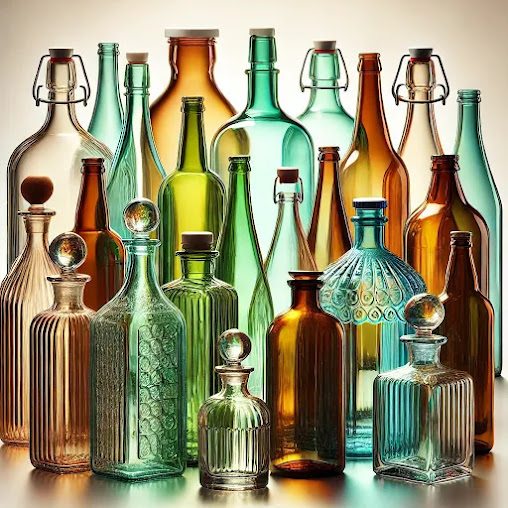Glass Recycling: Color Differences & Non-Recyclable Glass Explained
Understanding Glass Recycling: Color Differences & Non-Recyclable Types
Glass is one of the most recyclable materials, but its color plays a crucial role in how it’s processed. Additionally, not all glass is recyclable. Let’s break down how glass colors affect recycling and explore types of glass that can’t be recycled through traditional means.
 |
| A collection of glass bottles in various colors, including clear, green, brown, blue, and amber, arranged in a visually appealing manner. |
Glass Colors and Recycling
Different colors of glass contain unique chemical additives, impacting their reuse in new glass production. Here’s how they compare:
1. Clear (Flint) Glass
- The most versatile and widely recycled.
- Can be remelted into new clear or colored glass products.
2. Green Glass
- Contains metal additives like iron and chromium.
- Can accommodate small amounts of other colors in recycling.
- Best reused in new green glass production.
3. Brown (Amber) Glass
- Made with iron, sulfur, and carbon.
- Commonly used for beer bottles and pharmaceuticals.
- Typically recycled into new amber glass.
4. Blue and Other Colored Glass
- Often colored with cobalt or other rare additives.
- Less common, making it harder to recycle.
- Sometimes mixed with green glass but not widely accepted.
5. Mixed Glass
- Combining different colors results in lower-quality recycled material.
- Can only be repurposed for darker glass products.
Recycling Considerations:
- Separation is Key: Many recycling centers require color sorting.
- Avoid Contamination: Labels, caps, and non-recyclable glass must be removed.
- Market Demand Matters: Clear and amber glass have higher demand than other colors.
Non-Recyclable Glass Types
Certain types of glass can’t be recycled due to their chemical composition, melting point, or added materials. Here are the main ones:
1. Heat-Resistant Glass (Pyrex, Borosilicate Glass)
- Used for bakeware and lab glass.
- Higher melting point disrupts standard recycling processes.
2. Tempered Glass
- Found in car windows, shower doors, and cookware lids.
- Treated to break into small pieces, making it non-recyclable.
3. Window and Mirror Glass
- Includes home windows and mirrors.
- Often contains coatings or adhesives that prevent recycling.
4. Laminated and Wired Glass
- Used in windshields and security glass.
- Layers of plastic or wire mesh make separation difficult.
5. Crystal and Leaded Glass
- Found in fine glassware and decorative pieces.
- Contains lead and other heavy metals, contaminating the recycling stream.
6. Ceramics and Stoneware
- Includes plates, mugs, tiles, and pottery.
- Not made of traditional glass, so it can’t be recycled with glass containers.
7. Fluorescent and LED Light Bulbs
- Contain hazardous materials like mercury or phosphor coatings.
- Require special disposal methods.
Eco-Friendly Ways to Repurpose Non-Recyclable Glass
Instead of discarding non-recyclable glass, consider upcycling it into creative projects:
- Tempered Glass: Transform into garden stepping stones or mosaic art.
- Window Glass & Mirrors: Frame for DIY decorative wall art.
- Crystal & Leaded Glass: Repurpose as jewelry or sun catchers.
- Ceramics & Stoneware: Break into pieces for mosaic projects.
By understanding glass recycling and repurposing non-recyclable types, we can reduce waste and make more sustainable choices. Have you repurposed glass in a creative way? Share your ideas in the comments!









Comments
Post a Comment